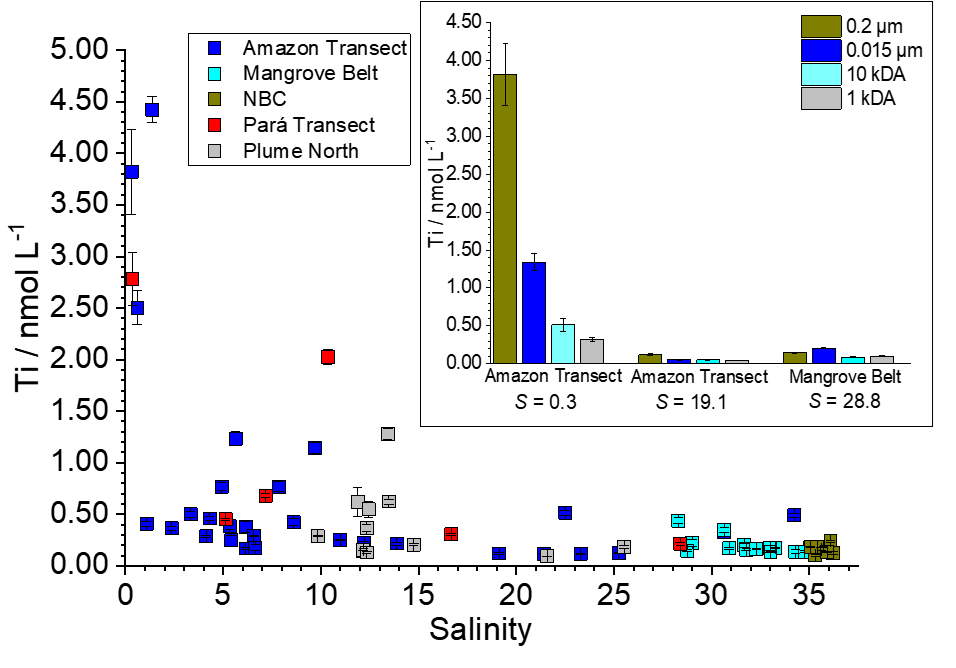When titanium is not always behaving as a lithogenic conservative tracer: an Amazon estuary story
In the framework of the GEOTRACES process study GApr11, Schneider et al. (2022, see reference below) established the distribution of dissolved, particulate and colloidal titanium (Ti) in the estuaries of the Amazon and Pará rivers and their related plume, which moves northwest with the North Brazil Current into the Atlantic Ocean during the high discharge period (April-May 2018). They also documented the main end members of this major estuarine system, i.e the rivers Tocantins, Amazon and Pará and Atlantic seawater. This impressive set of data allowed them to establish that:
- The surface water concentration of dissolved Ti was much higher in the river end member than in the seawater end member and was rapidly depleted at low salinity ranges (below 3), confirming that Ti is a particle-reactive element behaving non-conservatively along the salinity gradient.
- However, at medium salinity ranges (5-17), desorption of Ti from the particle was observed. This fate is similar to the phosphate one and the sorption-desorption processes were attributed to exchanges with colloidal or particulate Fe.
- The ultrafiltration of 3 samples revealed that truly dissolved and colloidal forms are detected everywhere, but in strongly varying proportions: while the truly dissolved fraction in river water represents only 13% of the total, this proportion reached 60% in the seawater end member (with 100% of Ti is assumed to be in the soluble phase in this end member).
- Regarding the vertical distribution of Ti, it displayed lowest concentrations in surface water, but no clear biological uptake release is identified.
- Despite the recent development of anthropogenic activities in the Amazon basin, concentrations and trends in the Amazon estuary are similar to those published almost 30 years ago, which may indicate that it may still be possible to determine a natural baseline for Ti in this area.

Figure: Distribution of dissolved Ti (<0.2 µm) along the salinity gradient in samples collected during the cruise in the Amazon and Pará estuaries, showing strong removal of Ti at initial mixing of river water and seawater and an appreciable remobilization of soluble Ti in the lower-mid salinity range. Samples were grouped according to their origin into Amazon transect, Pará transect, river plume moving north (Plume North), Mangrove Belt to the southeast of the Pará river mouth, and North Brazil Current (NBC, seawater end member). The insert shows Ti concentrations after different pore size filtration and ultrafiltration for three selected samples with different salinities, revealing colloidal and truly dissolved Ti fractions along the gradient and strong removal of the colloidal fraction at higher salinities.
Reference:
Schneider, A. B., Koschinsky, A., Krause, C. H., Gledhill, M., & de Carvalho, L. M. (2022). Dynamic behavior of dissolved and soluble titanium along the salinity gradients in the Pará and Amazon estuarine system and associated plume. Marine Chemistry, 238, 104067. Access the paper: 10.1016/j.marchem.2021.104067
